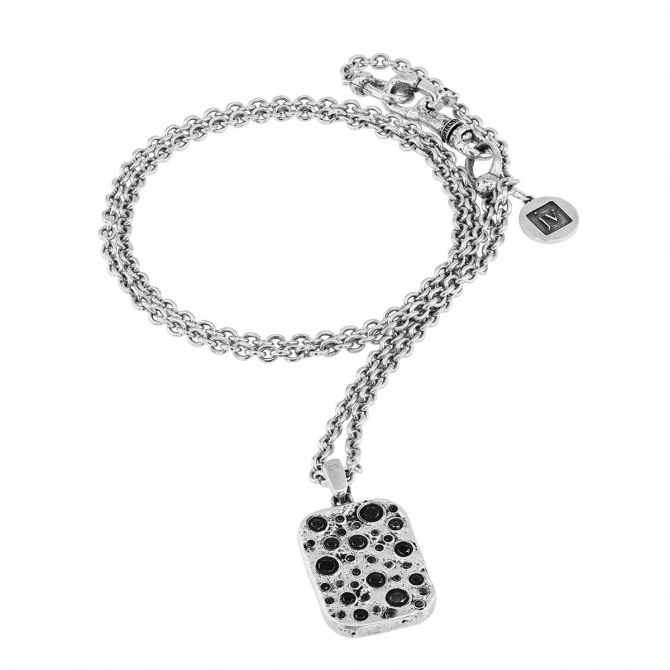Unfortunately, not all that glitters can swim—your necklaces included. However, there are types of jewelry that can withstand minor water exposure, which is why we favor the term “water-resistant necklaces” as opposed to “waterproof necklaces.” While these expressions are often used interchangeably and necklaces are typically advertised as waterproof, all jewelry is subject to some degradation over time, making it resistant—but not proof—to water.
While no necklace can claim to be entirely waterproof, with the right knowledge and practices, you can safeguard your jewelry from those unavoidable run-ins with water.
Factors Affecting Necklace Water Resistance
The water resistance of a necklace is largely dependent on a few factors: necklace metal type properties of gemstones in your necklace craftsmanship and material quality—which is why we only source our jewelry from reputable designers.
Level of Protection by Material
Not all necklace metals and gemstones are created equal. Read on to find out just how water resistant certain jewelry metals and gemstones are.
Titanium
Titanium necklaces are exceptionally resistant to corrosion from saltwater and chlorine. They’re also very lightweight. This makes titanium a practical metal for necklaces, without compromise, for water enthusiasts and those who lead active lifestyles.
Platinum
Platinum is a remarkably durable necklace option due in full to its high density and non-reactive properties. The substantial weight and strength of this metal protects it against damage that might compromise its appearance or structural integrity. Platinum necklaces have less of an edge over titanium necklaces because they are less resilient to saline environments.
If you prefer low-maintenance necklaces that are resistant to most water situations, titanium and platinum necklaces are ideal options.
Gold
Gold is a very stable element; it repels oxidation and corrosion when subjected to water, thus retaining its luster over time. The purer the gold, the better it resists water. But the purer it is, the softer it gets, making it more fragile. That’s why higher-karat gold is commonly alloyed with other metals like copper or rhodium, balancing bling and strength.

Sterling Silver and Brass
Do not expect your sterling silver necklaces to survive a dive or even a dip! Any necklace comprised of sterling silver should be kept far away from bodies of water. Exposure to chlorinated water not only leads to tarnishing but can also result in irreversible damage. Even water with little to no chemical content can dull the metal faster.
Brass necklaces, like sterling silver, are more susceptible to deteriorating rapidly over time. When you wear brass jewelry, your skin acids and salts from sweat interact with the metal and accelerate the process uncontrollably.

Gemstone
Gemstone necklaces require a little extra TLC and regular checkup even when not in direct contact with water. The elements in the stones can react with water, changing their appearance or even causing damage. Two main attributes matter when it comes to the water resistance of gemstones: hardness and porosity. Hardness, as measured on the Mohs Scale, is like a gem’s toughness. Stones with a higher rating can handle water better than softer stones. Porosity refers to the amount of liquid a stone can soak up. Gemstones with a lower porosity don’t absorb water as easily, so they’re less likely to get damaged.
Diamonds are the hardest material on Earth. It’s no wonder then that they’re commonly chosen for daily wear jewelry, like engagement rings. Diamonds are composed of a single element: carbon, whose arrangement contributes to the diamond’s brilliant quality. Diamonds earn a perfect 10 on the Mohs Scale of Hardness. They also lack the channels that allow water to penetrate and cause damage. This repertoire ensures your diamonds retain their shine even if they do get wet.
There are other hard gemstones (>5 on the Mohs Scale) that exhibit resilience to water. Quartz crystals, such as amethyst and citrine, are one such example.
Out of abundance of precaution, we advise you not to prolong water exposure to any gemstone below a hardness of 5 on the Mohs Scale. Pearls (level 2.5-3 level hardness) are particularly sensitive to water. Their composite is so porous that the stones will dull and eventually deteriorate if in extended contact with water.
Opals (level 5-6.5 hardness) are a unique case. Solid opal actually contains water, so immersing it in water does little harm. On the other hand, opals that have been layered—either as doublets or triplets—with additional materials will suffer water damage, which can manifest as cracking and/or an altered, cloudy appearance.
The Mohs Scale, while useful, is not the sole determinant of a gemstone’s water resistance. The material composite of these stones varies, and the minerals may still incur damage from water despite their Mohs rating. A hard gemstone like Topaz (level 8 hardness) can break from sudden temperature fluctuations. Peridot (level 6-7 hardness), the gem variant of the mineral Olivine, is susceptible to chemical weathering when exposed to moisture, dulling its sheen and ruining its integrity. Turquoise (level 5-6 hardness) is porous in nature and absorbs substances from the liquids it comes into contact with, leading to a number of defects. Water also removes the natural oils of turquoise, drying out the stone and leading to cracks.
Prevention and Aftercare
Always take off your necklaces before you shower, swim, or exercise. Water and certain chemicals, e.g. chlorine, within can mess with the material, causing it to tarnish or change color. Sweat can speed up the tarnishing process for some materials too. We recommend storing your necklaces in a dedicated, dry storage spot while you enjoy the water. If your necklaces accidentally get wet, immediately dry them off thoroughly with a soft cloth; this will help prevent any water spots or damage. Materials like titanium and platinum will not show the wear and tear of these events like sterling silver and brass. If you notice any discoloration or changes in your jewelry, bring it to our jewelers for proper cleaning and restoration.
It is tempting to wear your favorite jewelry everywhere, but some fine jewelry is not meant for water. Even water-resistant necklaces require careful handling to prolong their lifespan. When in doubt, refer to the care instructions provided at the time of purchase or call us at 402.391.0400.

